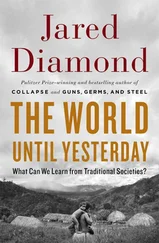Jared Diamond - Guns, Germs & Steel
Здесь есть возможность читать онлайн «Jared Diamond - Guns, Germs & Steel» весь текст электронной книги совершенно бесплатно (целиком полную версию без сокращений). В некоторых случаях можно слушать аудио, скачать через торрент в формате fb2 и присутствует краткое содержание. Жанр: 105. Описание произведения, (предисловие) а так же отзывы посетителей доступны на портале библиотеки ЛибКат.
- Название:Guns, Germs & Steel
- Автор:
- Жанр:
- Год:неизвестен
- ISBN:нет данных
- Рейтинг книги:5 / 5. Голосов: 1
-
Избранное:Добавить в избранное
- Отзывы:
-
Ваша оценка:
- 100
- 1
- 2
- 3
- 4
- 5
Guns, Germs & Steel: краткое содержание, описание и аннотация
Предлагаем к чтению аннотацию, описание, краткое содержание или предисловие (зависит от того, что написал сам автор книги «Guns, Germs & Steel»). Если вы не нашли необходимую информацию о книге — напишите в комментариях, мы постараемся отыскать её.
Guns, Germs & Steel — читать онлайн бесплатно полную книгу (весь текст) целиком
Ниже представлен текст книги, разбитый по страницам. Система сохранения места последней прочитанной страницы, позволяет с удобством читать онлайн бесплатно книгу «Guns, Germs & Steel», без необходимости каждый раз заново искать на чём Вы остановились. Поставьте закладку, и сможете в любой момент перейти на страницу, на которой закончили чтение.
Интервал:
Закладка:
134 " GUNS, GERMS, AND STEEL
Africa, southern Asia, and eastern Australia, some of them closely related to Olea europea, but none of them was ever domesticated. Similarly, while a wild apple species and a wild grape species were domesticated in Eurasia, there are many related wild apple and grape species in North America, some of which have in modern times been hybridized with the crops derived from their wild Eurasian counterparts in order to improve those crops. Why, then, didn't Native Americans domesticate those apparently useful apples and grapes themselves?
One can go on and on with such examples. But there is a fatal flaw in this reasoning: plant domestication is not a matter of hunter-gatherers' domesticating a single plant and otherwise carrying on unchanged with their nomadic lifestyle. Suppose that North American wild apples really would have evolved into a terrific crop if only Indian hunter-gatherers had settled down and cultivated them. But nomadic hunter-gatherers would not throw over their traditional way of life, settle in villages, and start tending apple orchards unless many other domesticable wild plants and animals were available to make a sedentary food-producing existence competitive with a hunting-gathering existence.
How, in short, do we assess the potential of an entire local flora for domestication? For those Native Americans who failed to domesticate North American apples, did the problem really lie with the Indians or with the apples?
In order to answer this question, we shall now compare three regions that lie at opposite extremes among centers of independent domestication. As we have seen, one of them, the Fertile Crescent, was perhaps the earliest center of food production in the world, and the site of origin of several of the modern world's major crops and almost all of its major domesticated animals. The other two regions, New Guinea and the eastern United States, did domesticate local crops, but these crops were very few in variety, only one of them gained worldwide importance, and the resulting food package failed to support extensive development of human technology and political organization as in the Fertile Crescent. In the light of this comparison, we shall ask: Did the flora and environment of the Fertile Crescent have clear advantages over those of New Guinea and the eastern United States?
one of the central facts of human history is the early importance of the part of Southwest Asia known as the Fertile Crescent (because of the
APPLES OR INDIANS • 135
crescent-like shape of its uplands on a map: see Figure 8.1). That area appears to have been the earliest site for a whole string of developments, including cities, writing, empires, and what we term (for better or worse) civilization. All those developments sprang, in turn, from the dense human populations, stored food surpluses, and feeding of nonfarming specialists made possible by the rise of food production in the form of crop cultivation and animal husbandry. Food production was the first of those major innovations to appear in the Fertile Crescent. Hence any attempt to understand the origins of the modern world must come to grips with the question why the Fertile Crescent's domesticated plants and animals gave it such a potent head start.
tgure 8.1. The Fertile Crescent, encompassing sites of food production before 7000 b.c.
Fortunately, the Fertile Crescent is by far the most intensively studied and best understood part of the globe as regards the rise of agriculture. For most crops domesticated in or near the Fertile Crescent, the wild plant ancestor has been identified; its close relationship to the crop has been proven by genetic and chromosomal studies; its wild geographic range is known; its changes under domestication have been identified and are often understood at the level of single genes; those changes can be observed in
I 3 6 • GUNS, GERMS, AND STEEL
successive layers of the archaeological record; and the approximate place and time of domestication are known. I don't deny that other areas, notably China, also had advantages as early sites of domestication, but those advantages and the resulting development of crops can be specified in much more detail for the Fertile Crescent.
One advantage of the Fertile Crescent is that it lies within a zone of so-called Mediterranean climate, a climate characterized by mild, wet winters and long, hot, dry summers. That climate selects for plant species able to survive the long dry season and to resume growth rapidly upon the return of the rains. Many Fertile Crescent plants, especially species of cereals and pulses, have adapted in a way that renders them useful to humans: they are annuals, meaning that the plant itself dries up and dies in the dry season.
Within their mere one year of life, annual plants inevitably remain small herbs. Many of them instead put much of their energy into producing big seeds, which remain dormant during the dry season and are then ready to sprout when the rains come. Annual plants therefore waste little energy on making inedible wood or fibrous stems, like the body of trees and bushes. But many of the big seeds, notably those of the annual cereals and pulses, are edible by humans. They constitute 6 of the modern world's 12 major crops. In contrast, if you live near a forest and look out your window, the plant species that you see will tend to be trees and shrubs, most of whose body you cannot eat and which put much less of their energy into edible seeds. Of course, some forest trees in areas of wet climate do produce big edible seeds, but these seeds are not adapted to surviving a long dry season and hence to long storage by humans.
A second advantage of the Fertile Crescent flora is that the wild ancestors of many Fertile Crescent crops were already abundant and highly productive, occurring in large stands whose value must have been obvious to hunter-gatherers. Experimental studies in which botanists have collected seeds from such natural stands of wild cereals, much as hunter-gatherers must have been doing over 10,000 years ago, show that annual harvests of up to nearly a ton of seeds per hectare can be obtained, yielding 50 kilocalories of food energy for only one kilocalorie of work expended. By collecting huge quantities of wild cereals in a short time when the seeds were ripe, and storing them for use as food through the rest of the year, some hunting-gathering peoples of the Fertile Crescent had already settled down in permanent villages even before they began to cultivate plants.
Since Fertile Crescent cereals were so productive in the wild, few addi-
APPLES OR INDIANS • 137
tional changes had to be made in them under cultivation. As we discussed in the preceding chapter, the principal changes—the breakdown of the natural systems of seed dispersal and of germination inhibition—evolved automatically and quickly as soon as humans began to cultivate the seeds in fields. The wild ancestors of our wheat and barley crops look so similar to the crops themselves that the identity of the ancestor has never been in doubt. Because of this ease of domestication, big-seeded annuals were the first, or among the first, crops developed not only in the Fertile Crescent but also in China and the Sahel.
Contrast this quick evolution of wheat and barley with the story of corn, the leading cereal crop of the New World. Corn's probable ancestor, a wild plant known as teosinte, looks so different from corn in its seed and flower structures that even its role as ancestor has been hotly debated by botanists for a long time. Teosinte's value as food would not have impressed hunter-gatherers: it was less productive in the wild than wild wheat, it produced much less seed than did the corn eventually developed from it, and it enclosed its seeds in inedible hard coverings. For teosinte to become a useful crop, it had to undergo drastic changes in its reproductive biology, to increase greatly its investment in seeds, and to lose those rock-like coverings of its seeds. Archaeologists are still vigorously debating how many centuries or millennia of crop development in the Americas were required for ancient corn cobs to progress from a tiny size up to the size of a human thumb, but it seems clear that several thousand more years were then required for them to reach modern sizes. That contrast between the immediate virtues of wheat and barley and the difficulties posed by teosinte may have been a significant factor in the differing developments of New World and Eurasian human societies.
A third advantage of the Fertile Crescent flora is that it includes a high percentage of hermaphroditic "setters"—that is, plants that usually pollinate themselves but that are occasionally cross-pollinated. Recall that most wild plants either are regularly cross-pollinated hermaphrodites or consist of separate male and female individuals that inevitably depend on another individual for pollination. Those facts of reproductive biology vexed early farmers, because, as soon as they had located a productive mutant plant, its offspring would cross-breed with other plant individuals and thereby lose their inherited advantage. As a result, most crops belong to the small percentage of wild plants that either are hermaphrodites usually pollinat-mg themselves or else reproduce without sex by propagating vegetatively
Интервал:
Закладка:
Похожие книги на «Guns, Germs & Steel»
Представляем Вашему вниманию похожие книги на «Guns, Germs & Steel» списком для выбора. Мы отобрали схожую по названию и смыслу литературу в надежде предоставить читателям больше вариантов отыскать новые, интересные, ещё непрочитанные произведения.
Обсуждение, отзывы о книге «Guns, Germs & Steel» и просто собственные мнения читателей. Оставьте ваши комментарии, напишите, что Вы думаете о произведении, его смысле или главных героях. Укажите что конкретно понравилось, а что нет, и почему Вы так считаете.










